Tom French

First flight of a young Bald Eagle from the hack tower at Quabbin Reservoir in 1983. All photographs by Bill Byrne unless otherwise indicated.
No one really knows how common the Bald Eagle was in Massachusetts at the time of early European colonization. The first author to describe the early fauna of Massachusetts was Josslyn (1672), but he made no mention of eagles. Nesting had not been documented in the state for nearly 200 years when Allen (1864) reported that eagles had nested at Mount Tom, though it is more likely that they actually nested along the Connecticut River adjacent to Mount Tom, as they do today. Other nest sites reported from the 1800s included locations in Beverly (Anon. 1864), Cheshire (Faxon and Hoffmann 1900), Sunderland on Mount Toby (Stearns 1884), and Winchendon in 1887 (Howe and Allen 1901). The last generally accepted nest record was at Bear Hollow near Snake Pond, Sandwich (1900–1905, Hill 1965). In his Sportsman’s Scrapbook, John Phillips (1928) reported “… it should be recorded that Eagle Hill or Agawam River twenty-five years ago (about 1903) was a veritable resort for these great birds. On a fine morning in May or June when the alewives were well on the run, we could see from the camp door two or three, sometimes as many as five or six huge eagles sitting on the bare branches of a great dead white pine about a quarter of a mile up the stream. … But now that the alewives have failed to run as they used to on the Agawam, eagles have gone elsewhere, and one of the striking sights of that lovely river has passed forever.” Bagg and Eliot (1937) reported later dates for nesting pairs in Brookfield near High Rocks (1908–1920), Colrain (1930s), and Conway (1930s). While these reports were based on the presence of adults in the spring and summer when they should be on their breeding territories, and in Brookfield over a period of 12 years, no nests were ever located.

The view from one of the first Bald eagle nests built by a pair of eagles released from the hack tower at Quabbin Reservoir.
Deforestation in Massachusetts peaked in the 1830s, leaving a mostly open landscape across about 80% of the Commonwealth. Grassland species, including Upland Sandpiper, Grasshopper Sparrow, Vesper Sparrow, and Savannah Sparrow, were found in greater numbers than they ever have been, before or since. Wet meadows were mowed by horse-drawn equipment, providing habitat for Sedge Wren and Henslow’s Sparrow. Most of our large forest species, including Wild Turkey, black bear, fisher, beaver, moose, and others, disappeared with the trees. Even white-tailed deer became rare. This is probably also the period in which the Common Raven and most of the resident Bald Eagles disappeared from the state. While the loss of habitat was likely a significant driving factor for the disappearance of the Bald Eagle, they were also deliberately killed and their eggs were actively collected. Eagles were not illegal to kill until 1907 when the Massachusetts legislature passed a law prohibiting “the hunting of loons on fresh water and the hunting of eagles anywhere.” By then, all of the resident nesting eagles in Massachusetts may have already disappeared, and if not, they were certainly scarce. Bald Eagles were not protected by federal law until passage of the Bald Eagle Protection Act in 1940, but the United States territory of Alaska was exempted. Although the Migratory Bird Treaty Act had been passed in 1918, birds of prey, including the Bald Eagle, were not added to the Act until an amendment in 1962. The passage by the Alaskan legislature in 1917 of “An Act to preserve the food supply of Alaska and placing a bounty on eagles” provided a fifty-cent bounty to be paid for both feet of any eagle, but prohibited the use of poisons (DeArmond 2008). In 1923, the bounty payment was increased to a dollar. Between 1917 and 1953, a total 120,195 bounties were paid; this number does not account for the additional eagles killed whose feet were not turned in for the bounty, or the eagles that were wounded or killed, but not retrieved. The bounty was eventually rescinded as Alaska prepared to become the 49th state in 1959. An argument was made in the territorial legislature that it was not appropriate to be paying bounties on the symbol of the nation Alaska was about to join. Several Canadian provinces also paid bounties on Bald Eagles. Even the town of Vinalhaven, Maine established a twenty-cent bounty on Bald Eagles in 1806 (Lyons 1889).
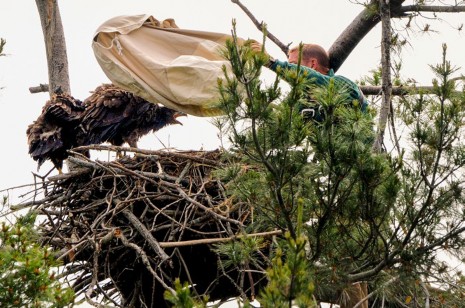
Kurt Palmateer of MassWildlife nets a Bald Eagle chick for banding in a nest on the Merrimack River in West Newbury.
The U.S. Fish and Wildlife Service (USFWS) has estimated that there may have been 300,000–500,000 Bald Eagles in North America in the 1700s, mostly in Alaska and northwestern Canada. By the time of heavy DDT use in the 1940s and 1950s, the Bald Eagle was long gone as a nesting bird in Massachusetts, and by 1963 the species had collapsed across the entire lower 48 states to only 487 documented nesting pairs, mostly as a result of eggshell thinning caused by the bioaccumulation of DDT. In that year, Rachel Carson’s book Silent Spring put a spotlight on the harm caused by DDT, and was a catalyst for the formation of the Environmental Defense Fund, founded in 1967 specifically to fight for a ban on the use of DDT. Also in 1967, the Bald Eagle was listed under the Endangered Species Preservation Act (a precursor to the Endangered Species Act of 1973) as federally Endangered in the lower 48 states, except Michigan, Minnesota, Wisconsin, Oregon, and Washington, where it was listed as Threatened. By 1973, the U.S. Environmental Protection Agency had banned most uses of DDT in the United States and set the stage for recovery efforts to begin. Interestingly, Massachusetts was one of the last states to totally ban the use of DDT. Until 1977, DDT was actively used as a tracking powder sprinkled at the entrances of bat colonies in houses. Bats would get the powder on their feet and fur as they entered and exited the colony and be poisoned after licking it off. DDT was considered “an acceptable and appropriate toxicant for eliminating bats, which pose a significant public health hazard.” (Wells and Girard 1977)

Pat Huckery and Erik Amati of MassWildlife band P/1 in West Newburyport, May 2012.
For over 30 years (1950s–1987), Maine was the only state in New England with nesting Bald Eagles. Even there, the numbers had plummeted to only about 21 pairs by 1967. In the next two largest eagle states in the East, New York and Pennsylvania, eagle numbers dropped to a low of one nonreproducing pair in New York (1974) and three nonreproducing pairs in Pennsylvania (1980). Unfortunately, the few surviving adults during this period were so heavily contaminated with DDT that their eggs failed to hatch year after year. The first conservation efforts taken in Maine and New York were to foster eggs and chicks taken from Midwestern and Alaskan parents relatively clean of DDT. These healthy eggs and chicks were given to some of the last old pairs who had constantly failed. For the first time in years, they were able to raise chicks again.
New York took the national lead to restore Bald Eagles by beginning the first hacking program for this species anywhere, just two years after the general use of DDT was banned. The strategy for hacking is simple. Chicks that are old enough to feed themselves are taken from wild nests, placed in cages on a tower and provided food until they are old enough to fly. Then they are released without any parents and quickly learn by instinct to fend for themselves. Without any parental instruction, they learn to hunt, court mates, set up territories, build nests and raise young. The point of release becomes the location from which they disperse. Some go far, but many stay very close to where they had been released, exactly as they would do if they had fledged from a nest. The system is simple but labor intensive. The most important step is to locate a donor population that is healthy enough to give up some of its eagle chicks. New York wanted to be sure to release enough chicks for the program to have a real chance of success, so they arranged to collect eagle chicks from Alaska where their numbers were high. Over a 13-year period from 1975 through 1988, New York released 198 Bald Eagle chicks from hack towers.
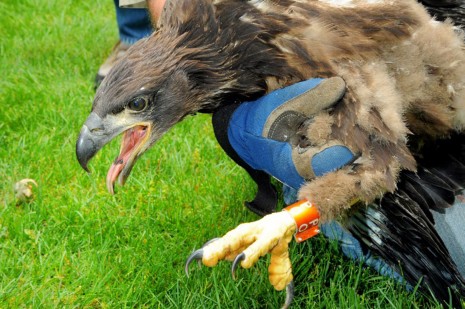
Bald Eagle chick P/0 just after being banded on June 1, 2010 in West Newbury. P/0 was next reported on March 9, 2014 as a near-adult on the Connecticut River in Enfield, CT.
Massachusetts was the fifth of ten eastern states and the District of Columbia to initiate a Bald Eagle hacking program. Over seven years from 1982 through 1988, 41 Bald Eagle chicks were released from a hack tower located at the mouth of Prescott Brook on the east side of the Prescott Peninsula at Quabbin Reservoir. The first two chicks came from Michigan. The second year, four chicks came from Manitoba, Canada, and for the last five years, chicks were taken from nests on Bras d’Or Lake, Cape Breton, Nova Scotia. Another nine captive-born eagle chicks were fostered into wild Massachusetts nests between 1990 and 1998. These early efforts have been well reported in a number of previous articles and updates (W.J. Davis 1983, 1987, 2011, D.B. Davis 2014, and others). In all, at least 1,016 Bald Eagle chicks were released in hacking programs in the eastern United States through 2015. In addition to New York and Massachusetts, programs were carried out in Georgia (89 birds, 1979–1995), Tennessee (370 birds, 1980–2015), Kentucky (1 bird in 1981), North Carolina (29 birds, 1983–1988), Pennsylvania (88 birds, 1983–1989), New Jersey (60 birds, 1983–1990), Alabama (91 birds, 1985–1991), Washington DC (16 birds, 1995–1998), and Vermont (29 birds, 2004–2008). The American Eagle Foundation in Tennessee is the only organization still hacking Bald Eagle chicks. In addition to Bald Eagles, over 165 Golden Eagles were released through hacking programs in the mountains of Georgia, North Carolina, and Tennessee between 1981 and 2006.
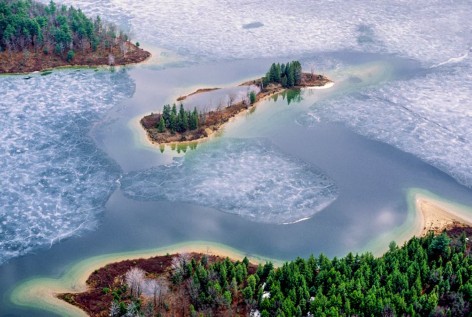
Spring ice-out on Quabbin Reservoir.
As a consequence of these hacking programs, the genetic makeup of northeastern Bald Eagles has been substantially mixed. The hacking programs of New York and Massachusetts alone brought birds from as far apart as Cape Breton, Nova Scotia, west to Alaska, and from several places in between, including Great Lakes states and Manitoba. Most of the 88 eagle chicks hacked in Pennsylvania came from Saskatchewan, Canada. These transplanted birds grew up to join our few surviving native birds in Maine, and a few elsewhere, to form a recovered population with much greater genetic diversity.
In Massachusetts, the first eagle chicks in modern times fledged from two different nests in 1989 at Quabbin Reservoir. In all, three chicks fledged that first year. Since then, our eagle population has continued to grow. By 2016, the Massachusetts Bald Eagle population included 54 known active nesting pairs, of which at least 45 laid eggs, and 36 successfully fledged 63 chicks. This was the 27th year that Bald Eagles have raised young in Massachusetts since their restoration. During these 27 years, at least 646 wild-born chicks are known to have fledged from Massachusetts nests, and undoubtedly, more have been raised in undiscovered nests. As large and showy as these birds are, and as grand as their nests can be, it is remarkable how long they can go undiscovered. As an example, adult Bald Eagles have been seen around Mashpee-Wakeby Pond during the nesting season since 2013, and Cliff Pond in Nickerson State Park, Brewster in 2015, but a nest has still not been documented on Cape Cod in modern times. I have no doubt that eagles already nest on the Cape, but it will take a sleuthing birder or dumb luck to eventually confirm. It is amazing that Common Ravens were confirmed nesting on the Cape before Bald Eagles.
From the beginning of recovery, MassWildlife has made an effort to band eagle chicks in their nests. In 2016, 44 of the 63 known chicks (70%) were successfully banded, and since 1989 when the first chicks fledged, 533 of the 646 known chicks (83%) have received bands. Each bird gets two bands. The first is a standard silver-colored aluminum band issued by the federal Bird Banding Laboratory, usually put on the right leg. The second is a field-readable color band usually put on the left leg. In the early years, our color bands were gold with black figures, but since 2007, Massachusetts eagles have been identifiable by their burnt orange bands with white figures. This color is also used in Quebec, but intended for resident adults, so there has been virtually no confusion. Other nearby states use black (New Hampshire, Vermont, Connecticut, Rhode Island), red (Maine), blue (New York), green (New Jersey), and red over black (New York). The unique letter/number code is repeated three times around the color band so that it can be read from nearly any angle. These bands were designed to be read by birders with spotting scopes, but now they are more often being read from digital photos. With the quality of modern digital cameras, an eagle flying down the middle of the Merrimack River can be photographed from shore, and the color band code can be read by enlarging a good high resolution photo.
Many remarkable records of travel, dispersals from fledging sites to eventual nesting sites, and records of individual life spans have been accumulated through reports of these bands. At least one bird, S/3, from Onota Lake in Pittsfield, Massachusetts, became a rock star as she was seen and photographed by hundreds of photographers for four consecutive winters (2011/12–2014/15) at the Conowingo Dam on the Susquehanna River between Maryland and Pennsylvania. She was huge, aggressive, and a great poser for the cameras. Then in 2015 she was photographed in Hancock, Hillsborough County, New Hampshire, and found nesting in Enfield, Grafton County, New Hampshire, in 2016.
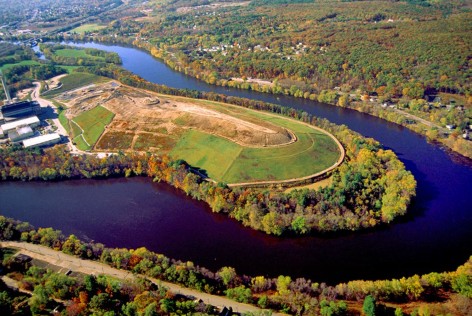
Good Bald Eagle habitat on the Merrimack River in Haverhill, MA.
Some states, but not Massachusetts, have attached modern satellite radio telemetry to eagles and receive thousands of location records as these birds move around. One bird banded in 2012 in New Jersey is now settling down on a section of the Connecticut River in Massachusetts and Connecticut.
While her radio signals constantly report that she is here, no birder has yet reported seeing an eagle with a radio backpack and trailing antenna. Clearly, modern technology has revolutionized how we can study these birds, and other wildlife.
The results of restoration efforts, in combination with natural recovery, have been remarkable. As their recovery took hold, then gained momentum, the Bald Eagle was down-listed from federally Endangered to Threatened in 1995, and was then completely removed from the Endangered and Threatened Species List in 2007. The population had come from a low of 487 nesting pairs in all of the lower 48 states in 1963, and rebounded to over 11,000 by the time the species was delisted. The population has continued to climb, and now may be somewhere between 15,000 and 20,000 nesting pairs.
In Massachusetts, the Bald Eagle was included as Endangered on the first regulatory list of Endangered, Threatened, and Special Concern Species in 1980 when no breeding birds were left, and was down-listed to Threatened in 2012 with 39 active nests. Only four years later, we have at least 54 active nests. The same story of recovery has played out across the Northeast. In 2016, there were about 165 active pairs in New England (excluding Maine): New Hampshire (42), Vermont (21), Massachusetts (54), Rhode Island (4), and Connecticut (44). The last statewide survey in Maine was in 2013 when 633 Bald Eagle nests were documented, but now the number, estimated by two different methods, is believed to be somewhere between 780 and 915 (Charlie Todd, per. comm.). In other nearby states, there were about 350 pairs in New York, 304 in Pennsylvania, and 160 in New Jersey in 2016. At this point, the question is how much more will Bald Eagle numbers increase in Massachusetts, and elsewhere, before they level off. And, can there be too many Bald Eagles? In Maine, a few Bald Eagles have become significant predators of seabirds, just as they are in Alaska. Eagles have apparently already wiped out the few Great Cormorants nesting on Maine islands. If there is any doubt that Bald Eagles can be efficient predators, watch the 2016 Osprey nest camera footage from the National Audubon Society’s Hog Island.
It took the cooperation of numerous organizations and individuals to make the Massachusetts Bald Eagle restoration efforts possible, but it was amazing how easy it was to invite people to join in to help this charismatic bird. This is in stark contrast to the difficulties encountered by a 2016 proposal to establish a population of state Endangered Timber Rattlesnake on Mount Zion Island in the Quabbin Reservoir for the purposes of having one population that can be protected from road mortality and deliberate killing by the public. Among the main cooperators in the early Bald Eagle restoration effort were the Metropolitan District Commission (MDC—now known as the Department of Conservation and Recreation—DCR) which manages the Quabbin Reservation; the USFWS, which has the responsibility for the Migratory Bird Treaty Act, the federal Endangered Species Act, and the Bald and Golden Eagle Protection Act; the Nova Scotia Department of Natural Resources, which provided the bulk of the eagle chicks; the Bank of Boston (now Bank of America) and the Massachusetts Audubon Society, which provided start-up funds; and Mass Electric (now National Grid), which for many years provided helicopter flight time to monitor the growing eagle numbers on Quabbin Reservoir and the Connecticut River. The Massachusetts Division of Fisheries and Wildlife (MassWildlife), as the state wildlife agency, took the lead role. Most of the annual monitoring and banding was done by MassWildlife’s five District Managers and District Wildlife Biologists, with the essential help of our primary climber, Kurt Palmateer, an Assistant Fish Culturist at the McLaughlin Fish Hatchery.
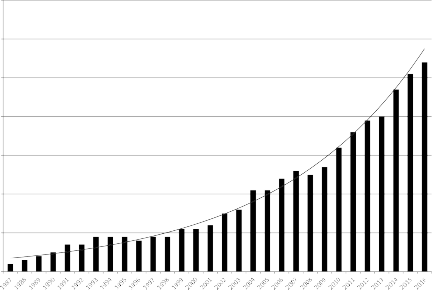
Figure 1. The increase in active pairs of Bald Eagles since the beginning of population recovery. Active pairs were pairs that had begun at least some nest construction. The graph is overlaid with an exponential growth curve.
Today, Bald Eagles are almost common in some parts of Massachusetts. Nearly anyone who fishes on the Quabbin Reservoir or boats on the Connecticut River will see at least one eagle during the day. As much as I have worked with Bald Eagles over the past three decades, I never get tired of them, and it looks like they are back to stay.
In Massachusetts, the Bald Eagle was included as Endangered on the first regulatory list of Endangered, Threatened, and Special Concern Species in 1980 when no breeding birds were left, and was down-listed to Threatened in 2012 with 39 active nests. Only four years later, we have at least 54 active nests (see Figure 1). The same story of recovery has played out across the Northeast.
Citations
- Allen, J. A. 1864. Catalogue of the birds found at Springfield Mass., with notes on their migration, Proceedings of the Essex Institute 4(4):48-98.
- Anonymous. 1864. Additions to the museum and library for April, May, and June 1864, Proceedings of the Essex Institute 4:36. (Young Eagle taken from the nest in Beverly, June 2d)
- Bagg, A. C. and S. A. Eliot Jr. 1937. Birds of the Connecticut Valley in Massachusetts. Northampton, MA: The Hampshire Bookshop.
- Davis, D. B. 2014. Eagle One: Raising Bald Eagles, A Wildlife Memoir. Worcester, MA: Chandler House Press.
- Davis, W. J. 1983. The Eagles Have Landed, Massachusetts Wildlife 34(1):2-8.
- Davis, W. J. 1987. The Waiting Game, Massachusetts Wildlife 37(1):13-19.
- Davis, W. J. 2011. Bringing Back Magnificence: 30 Years of Bald Eagle Restoration, Massachusetts Wildlife 61(1):12-25.
- DeArmond, R. N. 2008. Shoot the Damned Things! Alaska’s War Against the American Bald Eagle. Pp. 268-274 [In] B.A. Wright and P. Schempf (eds.). Bald Eagles in Alaska. Juneau, AK: Bald Eagle Research Institute, University of Alaska..
- Faxon, W. and R. Hoffmann. 1900. The birds of Berkshire county, Massachusetts, Collections of the Berkshire Historical and Scientific Society 3:107-166.
- Hill, N. P. 1965. The Birds of Cape Cod, Massachusetts. New York, NY: W. Morrow & Co.
- Howe, R. H. Jr. and G. M. Allen. 1901. Howe and Allen’s Birds of Massachusetts, The Auk 18:278.
- Josselyn, J. [1672] 1865. New-England’s Rarities Discovered, in Birds, Beasts, Fishes, Serpents, and Plants of that Country. Boston, MA: William Veazie.
- Lyons, O. P., L. W. Smith, T. G. Libby, G. Roberts, and H. Glidden. 1889. A Brief Historical Sketch of the Town of Vinalhaven. Rockland, ME: Free Press.
- Phillips, J.C. 1928. A Sportsman’s Scrapbook. Boston, MA: Houghton Mifflin Company.
- Stearns, W. A. 1884. Birds of Amherst, Bulletin of Massachusetts Natural History 1(1-4):6-23.
- Wells, L. F. Jr. and K. F. Girard. 1977. Bats, rabies and DDT—Massachusetts, New England Journal of Medicine Aug 18:297(7):390-392.
Dr. Tom French has been responsible for the Massachusetts Division of Fisheries and Wildlife’s Natural Heritage and Endangered Species Program since its inception 33 years ago. He grew up in Atlanta, Georgia, becoming active in the Atlanta Bird Club through the mentorship of a teacher in sixth grade, and getting his first introduction to New England though a scholarship from the, by then, Atlanta Audubon Society to attend National Audubon’s adult ecology camp on Hog Island, Maine. He is a past president of the Nuttall Ornithological Club, and has contributed previous articles to Bird Observer on Peregrine Falcons, Northern Ravens, and Leach’s Storm-petrels.